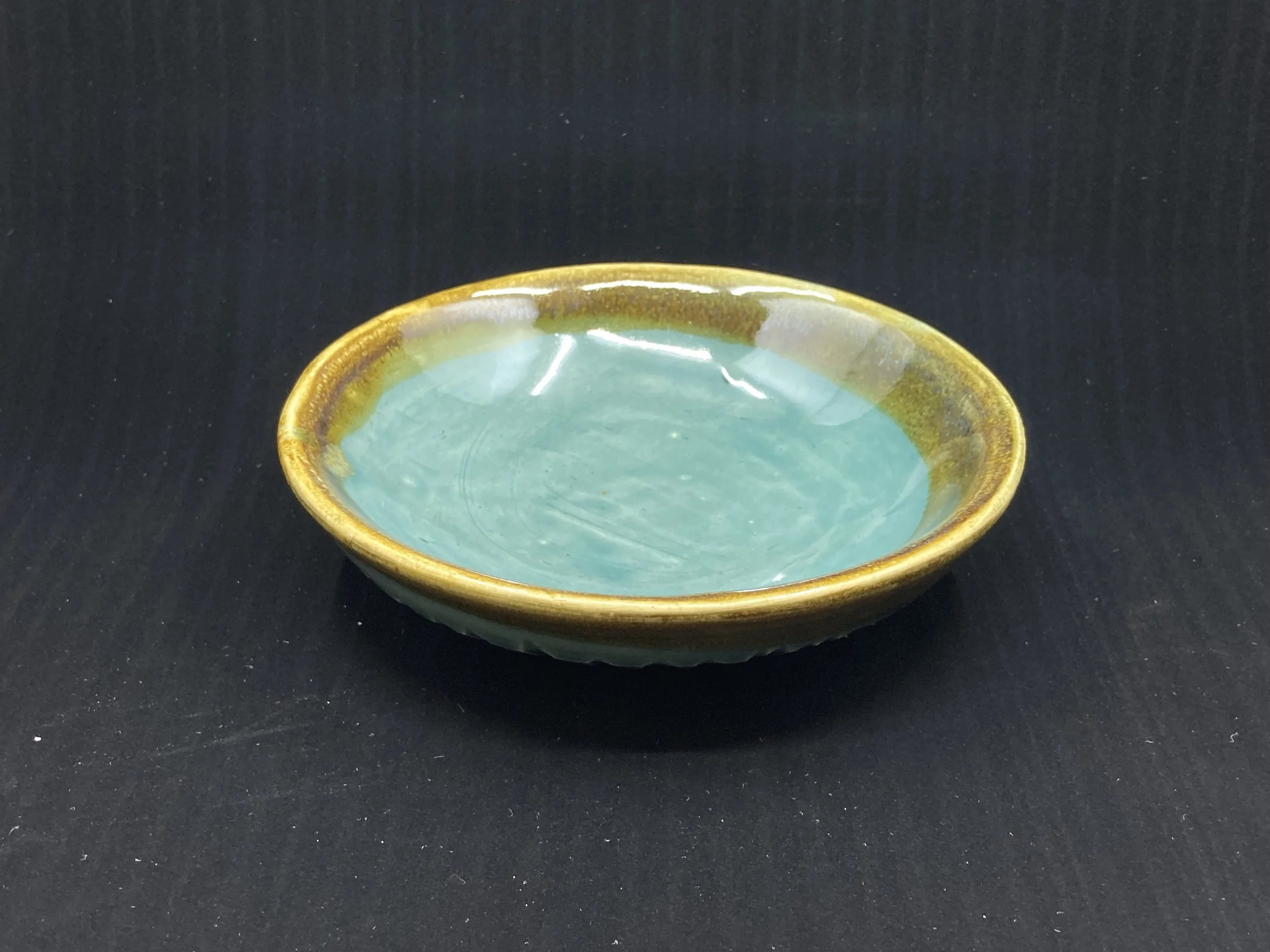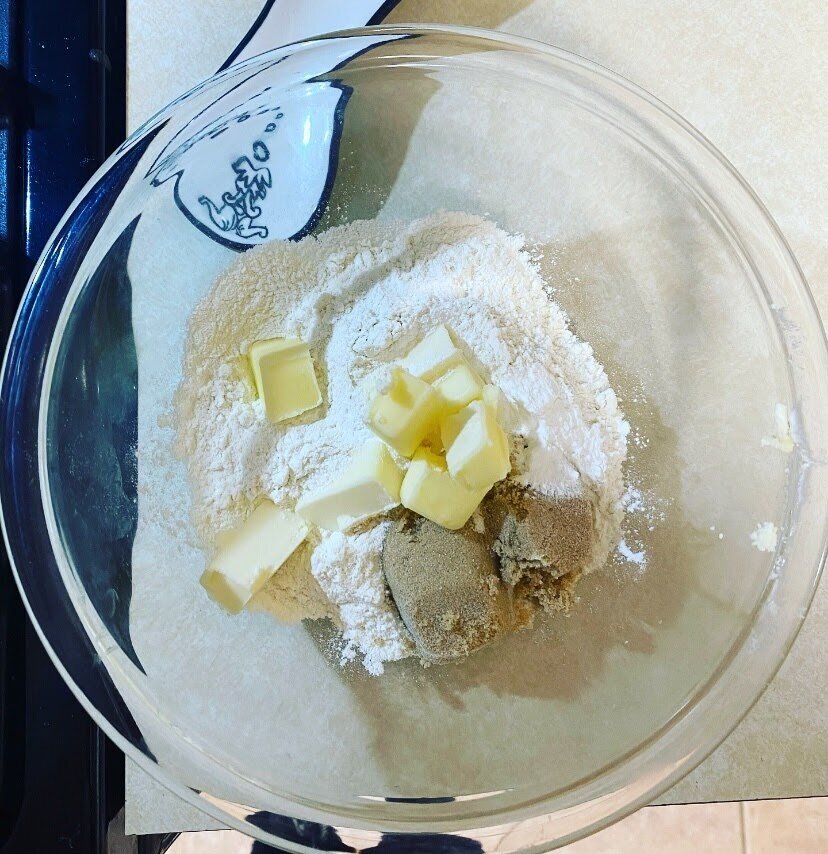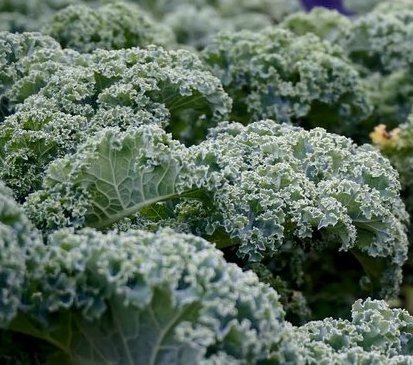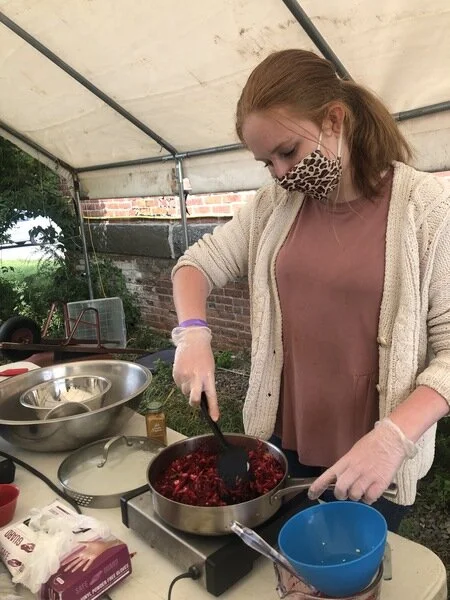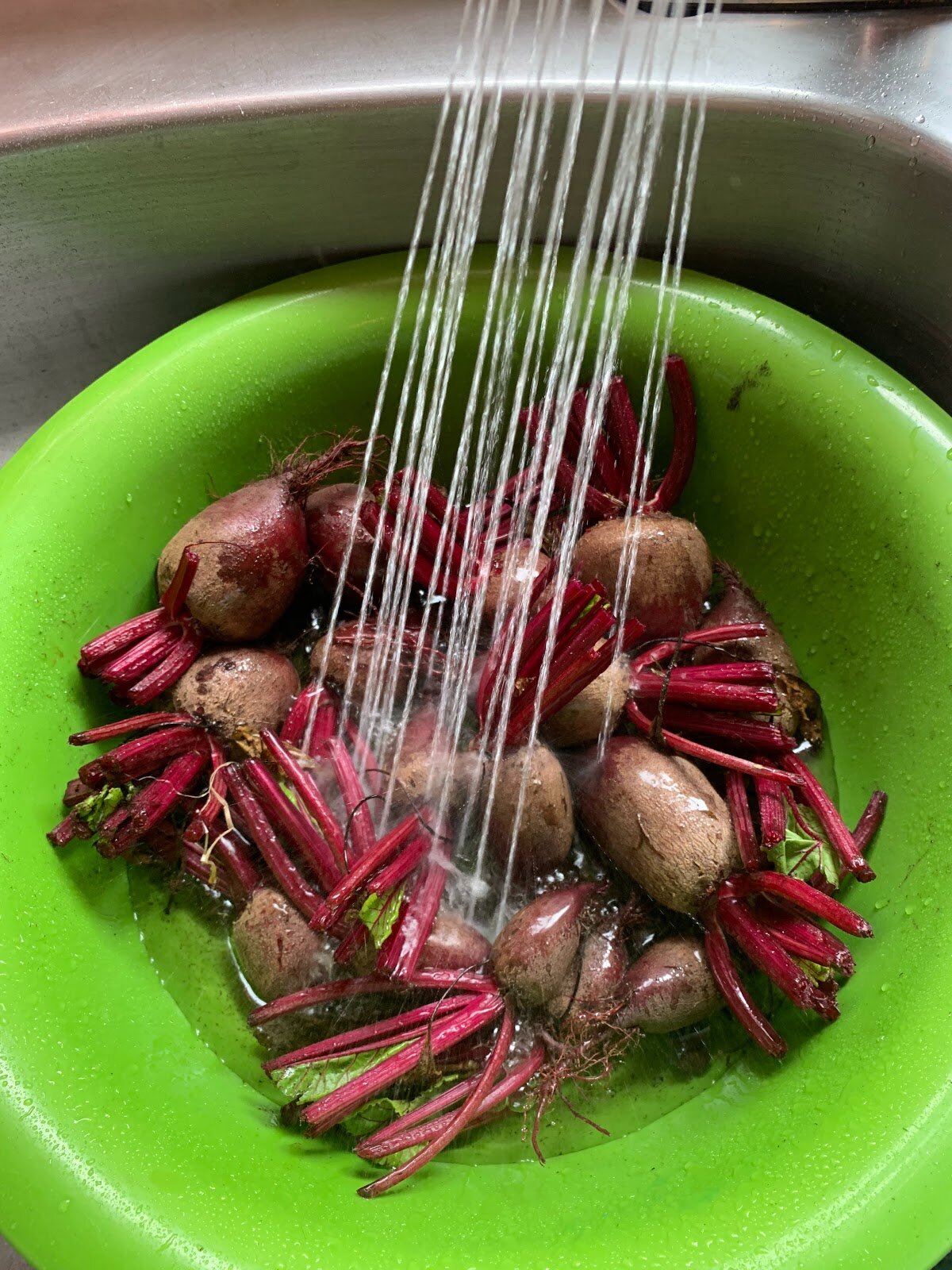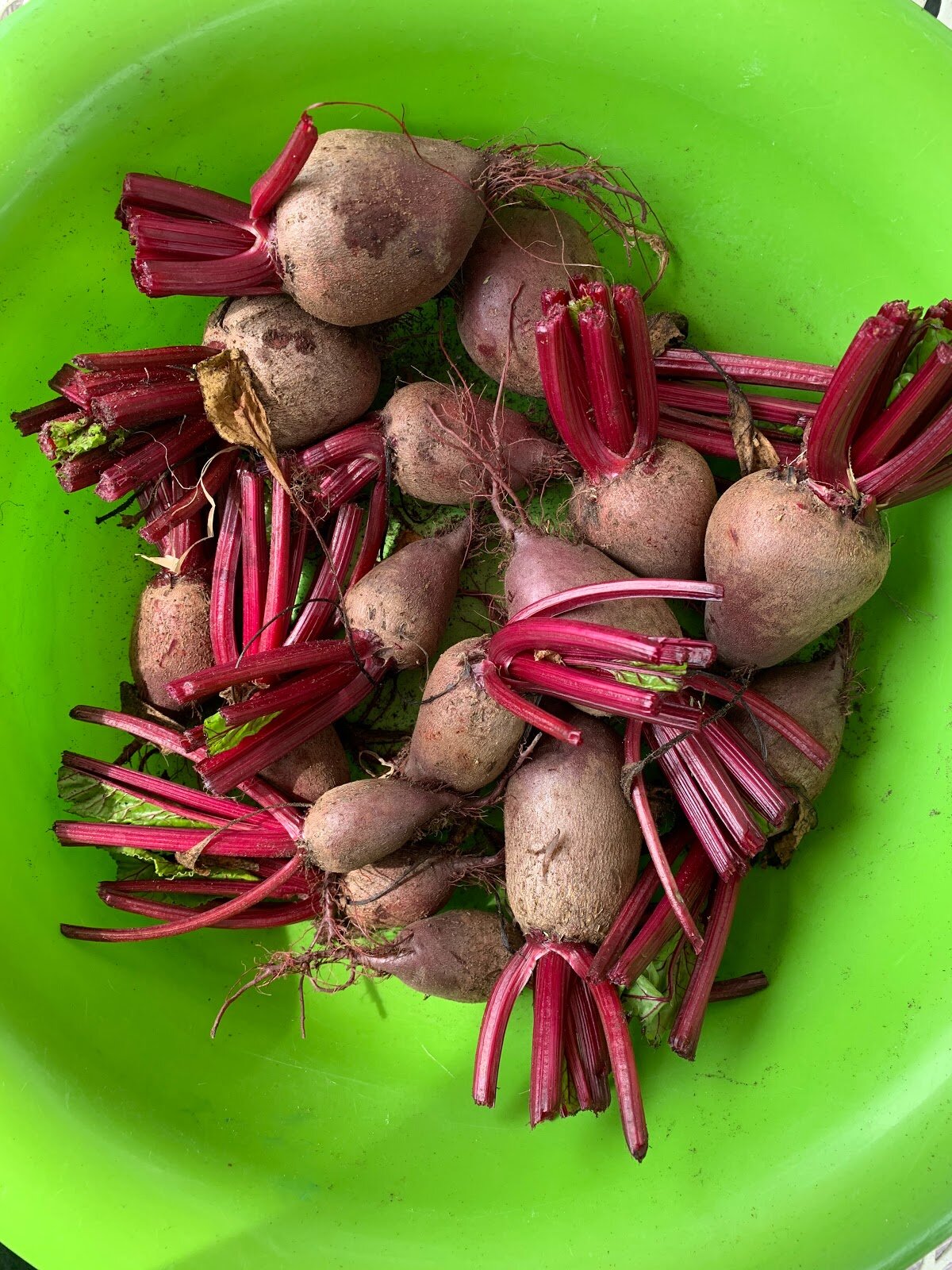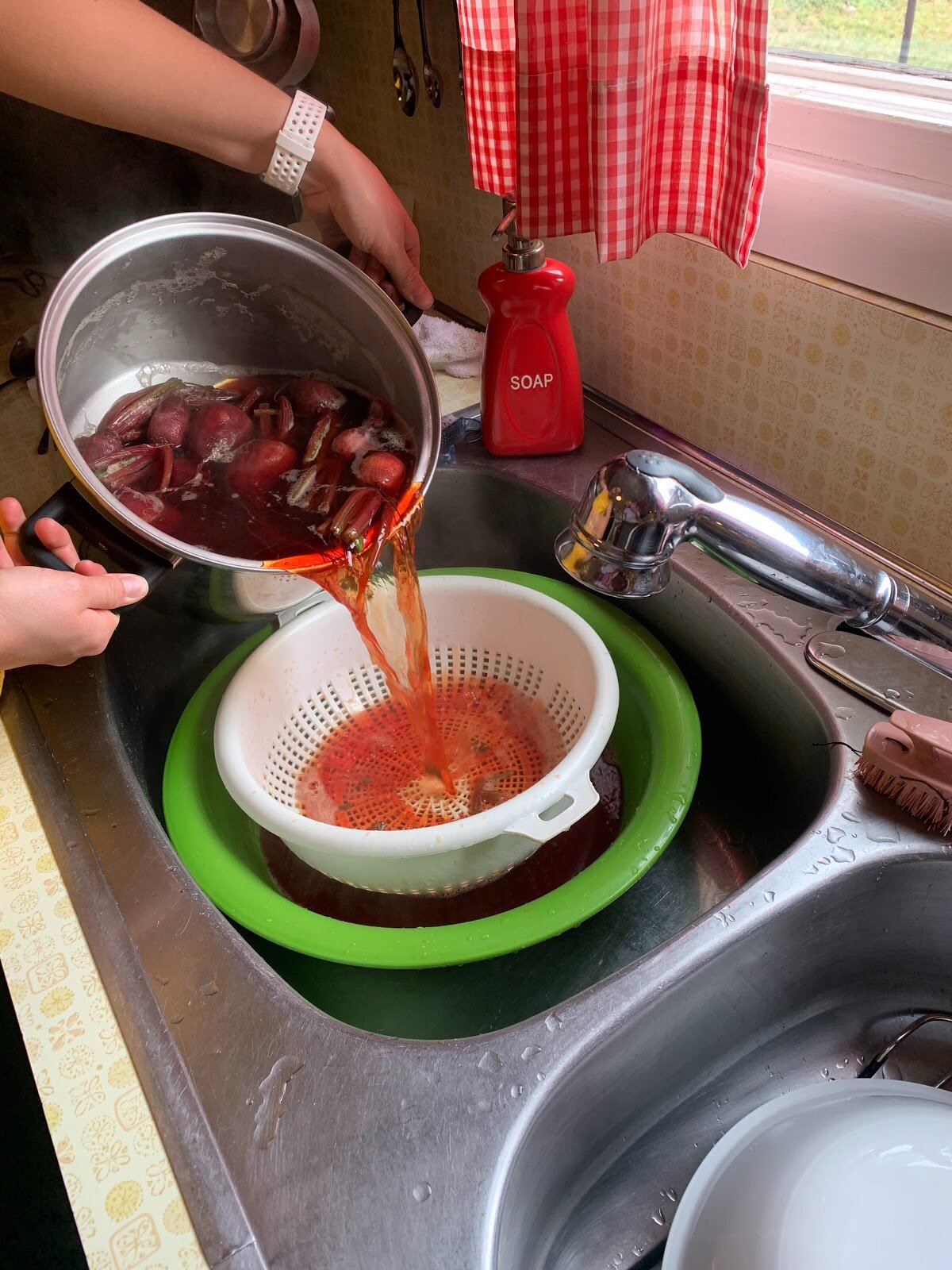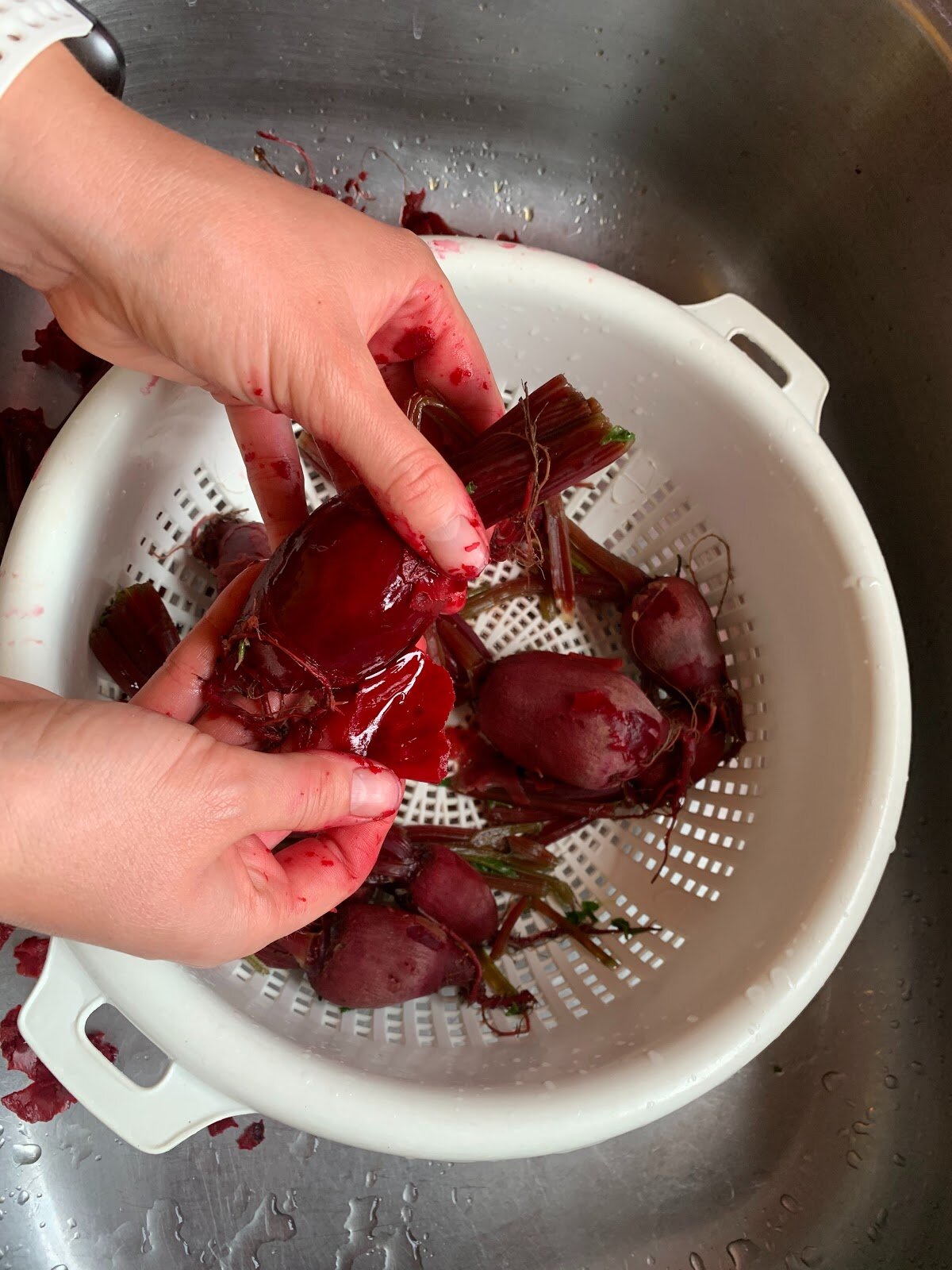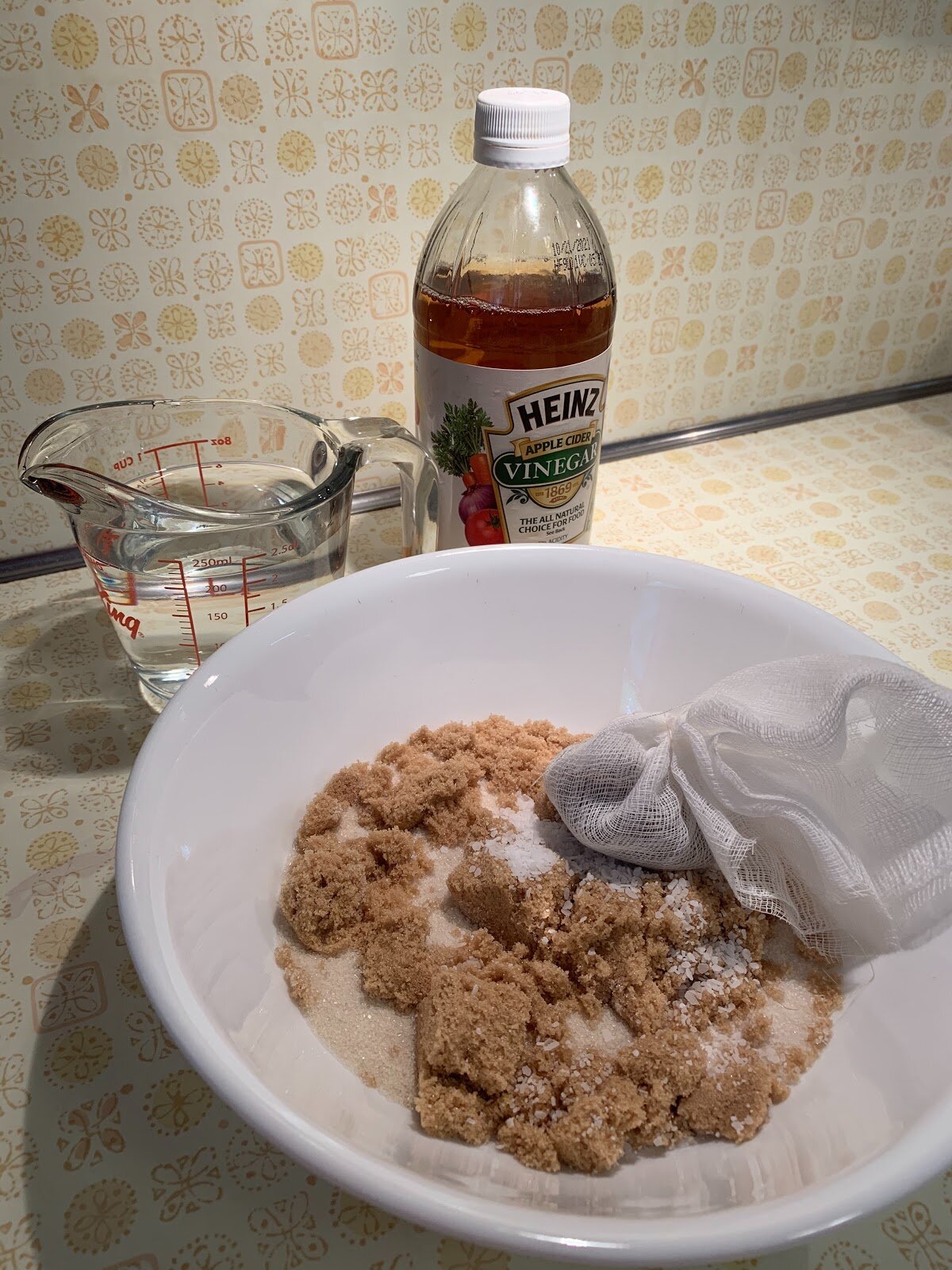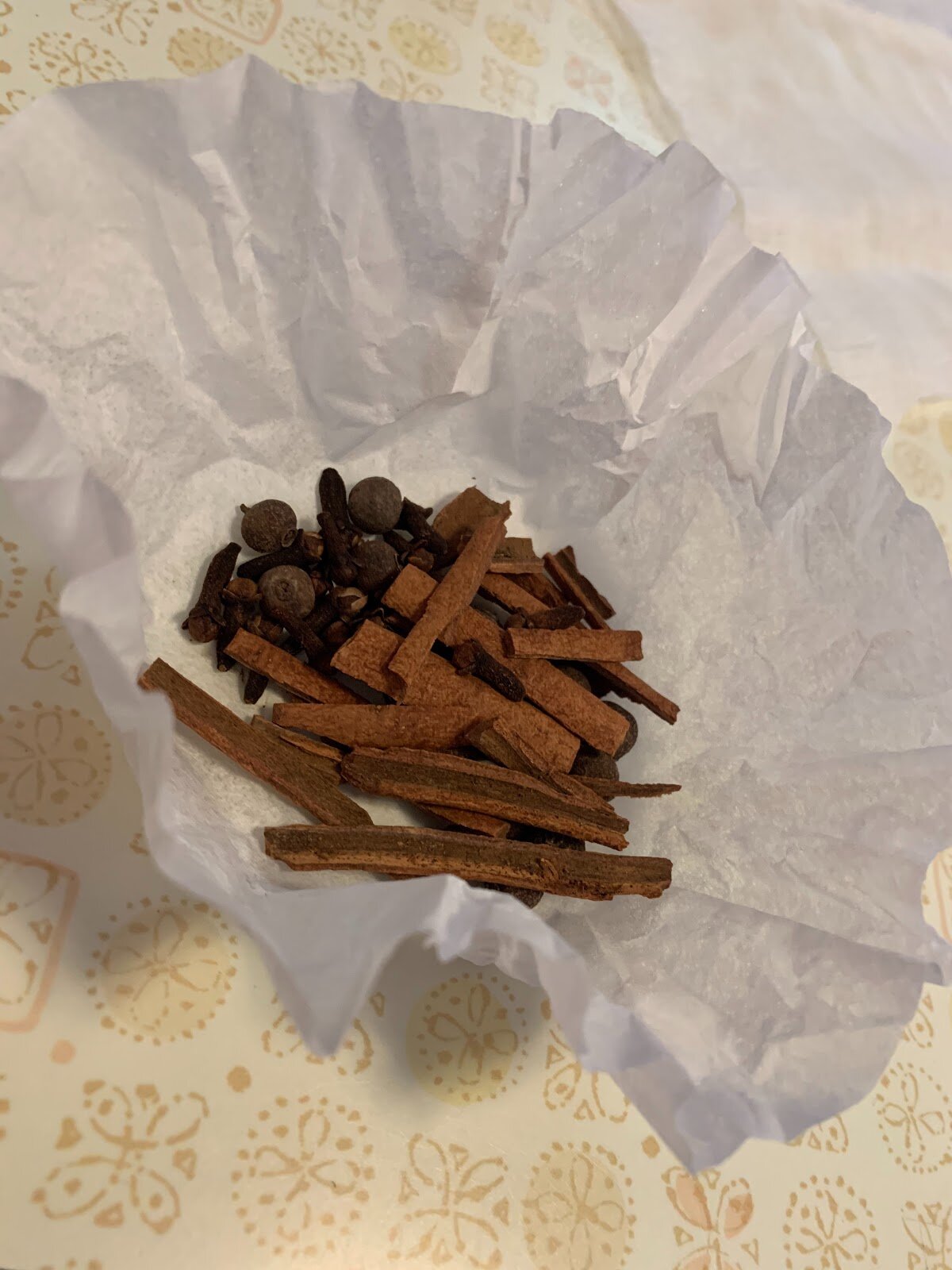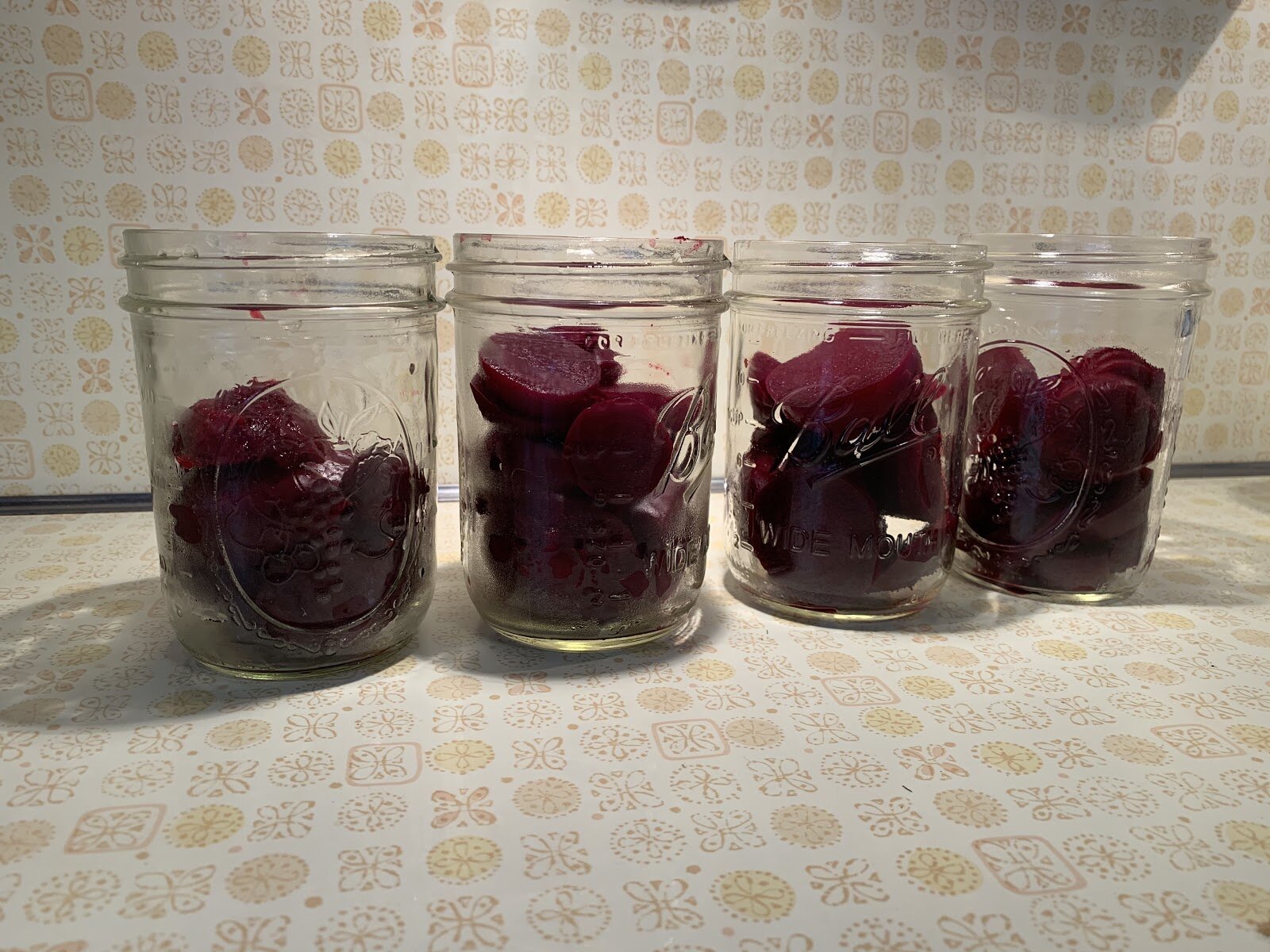Join Kathryn and the team at Poughkeepsie Farm Project to learn about winter squash, indigenous culture and farming practices! Then learn about a Haitian recipe using winter squash called Soup Joumou.
The word of the day is indigenous! Find out about the indigenous story and wisdom of the three sisters - corn, beans and squash and the practice of seed saving to grow the three sisters crops!
Relax and get centered with a mindful moment of deep breathing, and a nature moment in our seed saving garden. Then learn about indigenous seed keeper Rowen White who is growing ancestral Mohawk seeds with SeedShed in New York's Hudson Valley.
Companion Videos:
Cook Soup Joumou with SonyaJoy - English: https://youtu.be/z-QIYg8HMTE
Cook Soup Joumou with Laura - Spanish: https://youtu.be/wzx6lziND9Y
Learn more about Rowen's seed keeping work: https://youtu.be/IooHPLjXi2g
Follow us on Social Media
http://instagram.com/poughkeepsiefarm...
http://facebook.com/farmproject
http://twitter.com/farmproject
Get our Educator Newsletter or Monthly Newsletter: http://farmproject.org/home#list-sign-up
Squash Harvest of the Month resource page: http://farmproject.org/winter-squash
Resources for Educators on Squash: http://bit.ly/squashresources
More Online Learning with PFP: http://farmproject.org/digital-online...
Donate to support our work: http://farmproject.org/give
Credits:
Post-Production Editing by Forge Media
Intro Music: “Upbeat Funk Commercial” by GuitarsState
Mindful Moment Music: “Sweet Gentle Piano” by water_lily
Cinnamon Apple Scones
Cinnamon Apple Scones
By: Naomi Kohler, Culinary Institute of America Extern
Adapted from Taste of Home
*Makes 6 scones*
Scones are one of the oldest pastries ever made. They are a great way to use up leftover ingredients and still produce a baked good full of nutrients. Since apples are the Harvest of the Month for January, there are plenty to go around. This makes them the perfect addition to this breakfast favorite. Preparation is key to baking a perfect recipe. Make sure to read through each step before starting!
Glorie Farms apples
Preheat the oven to 400 degrees.
Step 1:
Grate one medium apple (about ⅔ cup)
Picking out the perfect apple can be hard with all of the varieties out there. I found that a golden delicious works the best but any apple will taste great. This is also a great time to use up that apple with the large bruise or even just one that may have been sitting too long. All you do is peel it and grate it into your bowl. Don’t forget the apple skin you peeled off is still full of nutrients and makes a great mid baking snack!
Step 2:
In a separate bowl add all of the dry ingredients, flour, brown sugar, baking powder, cinnamon and salt. Then cut in the butter.
Now for the part where you get your hands dirty. Once all the dry ingredients are mixed together, you want to toss in quarter sized pieces of cold butter. Use your fingers to crumble those pieces around in the dry mixture until they are the size of a pea. This helps the dough to form flaky layers when the scones are put in the oven.
Step 3:
To the bowl with the apple, add the half and half, egg yolk, and vanilla.
Pour the dry ingredients into this mixture, and stir until just moistened.
Mixing these together can be done with a spoon or any tool of choice, I normally stick to a spatula to make sure everything is mixed. It is important to only wet the dry ingredients, as if they are mixed too long they might make the dough tough. Although like most things in baking that can be fixed in the next step.
Step 4:
Knead the dough 10 times on a floured surface. Then shape into a circle. This can get very, very sticky so be careful. Make sure to put flour on the counter and your hands, although this looks messy it will help the surface stay clean in the long run. A great tip is to always have a second person around in case the surface or your hands did not have enough flour. If that isn’t possible make sure to leave yourself a small bowl that you can reach into, this is known as “bench flour”. Only kneading the dough 10 times helps to make sure the dough is not tough. If you think that you mixed it too long in the last step you can always knead less, just make sure that all the flour is not visible.
A great way to judge how thick the circle should be is to use your finger. It should be about up to the first knuckle on your pointer finger, or you can make it however thick or skinny you want!
Step 5:
Cut the circle into 6 pieces, then place on a greased baking sheet and put into the oven for 15-20 minutes, or until golden brown.
Caution: This step involves using a knife. Always make sure there is another person around. Now all that is left is portioning out the pieces. The best way to cut them is always going through the same center point, and cutting it just like a pizza. Then place them right on a baking sheet, spread about an inch apart, and into the oven. For a more clean look make sure to brush off any “bench flour” that may be left.
Step 6:
Enjoy them fresh!
The most fun part of any recipe is taking a step back and looking at all the hard work that was put into making these delicious treats. It is also important to remember the farmers who helped get the products to you! We are able to provide fresh, local apples to our community thanks to the farmers at Glorie Farms (Marlboro, NY).
For more recipes with Apples, head over to our Harvest of the Month Resource Hub!
Cinnamon Apple Scones
*Makes 6 scones*
Ingredients:
1 ½ cups whole wheat (or white) flour
2 tablespoons brown sugar
1-1/2 teaspoons baking powder
3 tablespoons cold butter
1/4 cup plus 2 tablespoons half-and-half
1 large egg yolk
1-1/2 teaspoons vanilla extract
2/3 cup shredded peeled apple (1 medium apple)
1 teaspoon cinnamon
Directions:
Grate the apple into a medium bowl.
In a small bowl, combine the flours, brown sugar, baking powder, cinnamon and salt. Cut in butter until mixture resembles coarse crumbs.
In a bowl with the apple , whisk the cream, egg yolk and vanilla; add to dry ingredients just until moistened.
Turn onto a floured surface; knead 10 times.
Pat into a 5-in. circle. Cut into 4 wedges. Separate wedges and place on an ungreased baking sheet. Bake at 400° for 15-20 minutes or until golden brown.
Cool for 10 minutes and enjoy!
West African Jollof Rice with Kale
Prepare West African Jollof Rice with Kale
Español abajo
Celebrate delicious local kale in a mouth-watering rice dish from Ghana, West Africa. This recipe is an adapted version of a traditional dish, changed to include a seasonal vegetable, plant-based protein, and simplified so even small children can help prepare it! Cook along with SonyaJoy as you dice, sauté and season your way to a dish that the whole family will enjoy. This video will describe where kids can safely get involved with cooking. For authentic Nigerian Jollof Rice, try Chef Yewande Komolafe’s traditional recipe featured in the NY Times.
Jump to the end of the video for the complete recipe. Visit our website for more distance learning videos and seasonal recipes.
Companion Video
Learn About Multicultural Kale with PFP: https://youtu.be/xASSV6jc3Fc
Chef Yewande Komolafe’s Nigerian Recipes, NY Times Cooking: https://www.nytimes.com/2019/06/24/dining/nigerian-food-yewande-komolafe.html
Follow us on Social Media
instagram.com/poughkeepsiefarmproject/
facebook.com/farmproject
twitter.com/farmproject
Get our Educator Newsletter or Monthly Newsletter: farmproject.org/home#list-sign-up
More Online Learning with PFP: farmproject.org/digital-online-learning
Donate to support our work: farmproject.org/give
Kale Harvest of the Month resource page: farmproject.org/kale
Resources for Educators on Kale: https://bit.ly/kaleresources
Tomato Harvest of the Month resource page: farmproject.org/tomatoes-1
Lesson Resource Page: Learn About Multicultural Kale with PFP
https://docs.google.com/document/d/1K...
Credits:
Close-up Cooking Video by Rob Kissner
Post-Production Editing by Forge Media
Intro Music: “Upbeat Funk Commercial” by GuitarsState
Mindful Moment Music: “Sweet Gentle Piano” by water_lily
Prepara Arroz Jollof de África Occidental con Lala M.
¡La cosecha del mes de noviembre en Poughkeepsie es la col rizada! Celebra la deliciosa col rizada local en un delicioso plato de arroz de Ghana, África occidental. Aprende a hacer esta sencilla receta de arroz Jollof con col rizada. Cocina junto con Lala Montoya mientras cortas, salteas y sazonas hasta obtener un plato que disfrutará toda la familia. Este video describirá dónde les niñes pueden participar de manera segura en la cocina. Salta al final del video para ver la receta completa. Visita nuestre sitio web para ver más videos de aprendizaje a distancia y recetas de temporada.
Página de la cosecha de col rizada del mes https://www.farmproject.org/kale
Más aprendizaje en línea con Poughkeepsie Farm Project, la granja de poughkeepsie https://www.farmproject.org/digital-o...
Créditos: Video de cocina de primer plano por Rob Kissner
Edición de postproducción por Forge Media
Música de introducción: "Upbeat Funk Commercial" de GuitarsState
Música de Momento consciente: "Sweet Gentle Piano" de water_lily
Musica principal: “Kids Background” de PeacockMusic
Learn About Multicultural Kale with PFP
Join Kathryn and the team at Poughkeepsie Farm Project to learn about kale, multicultural recipes, and more. Watch kale growing on the farm and get to know an important vegetable that helps kale grow strong - beans!
The word of the day is multicultural! Take a trip to Ghana through storytelling and a classic Ghanaian dish, Jollof Rice.
Relax and get centered with a mindful moment of deep breathing, and a nature moment out in the farm fields. Illustrate and color 3 different kinds of kale: Dinosaur, Red Russian, and Curly Kale.
Companion Videos:
Cook Jollof Rice with Kale - English: https://youtu.be/AUIT2eDMlP0
Cook Jollof Rice with Kale - Spanish (coming soon)
Follow us on Social Media
instagram.com/poughkeepsiefarmproject/
facebook.com/farmproject
twitter.com/farmproject
Get our Educator Newsletter or Monthly Newsletter: farmproject.org/home#list-sign-up
Kale Harvest of the Month resource page: farmproject.org/kale
Resources for Educators on Kale: https://bit.ly/kaleresources
More Online Learning with PFP: farmproject.org/digital-online-learning
Donate to support our work: farmproject.org/give
Anansi and the Pot of Beans (Animated Story for Kids): https://youtu.be/Sau3E2LEfcI
Credits:
Post-Production Editing by Forge Media
Intro Music: “Upbeat Funk Commercial” by GuitarsState
Mindful Moment Music: “Sweet Gentle Piano” by water_lily
Embracing Food and Community in the time of COVID-19
Written by Chris Gavin, Educator and After-School and Summer Program Coordinator
Youth intern and staff members preparing freshly harvested produce for donation
It would be an understatement to say 2020 has been a year like no other for Poughkeepsie Farm Project and how we offer educational opportunities to our community. Our world turned upside down in mid-March with the closure of schools in New York State, and all of our usual educational programs were abruptly halted. Since then, our team has been navigating the new realities of the COVID-19 pandemic and our country’s long-needed reckoning with systemic racism. The sudden upheaval to our work has given us a moment to pause and reflect on what we can do to better embody our mission of creating a just and sustainable food system in Poughkeepsie. Our education team has been digging into this important work with a sense of passion and joy to match the challenges of this unprecedented moment. While the structure and implementation of our programs has changed, the core goals of our work remain strong and in clear focus: making fresh vegetables and the means to prepare them at home accessible to our community AND engaging families in the important act of growing, preparing and eating healthy, nourishing, locally-grown foods.
Distance Learning
Poughkeepsie Food Power @Home, our new distance learning initiative, was born from our desire to stay connected with Poughkeepsie youth while in-person teaching isn’t possible. Our program consists of educational videosalong with cooking and gardening kits so families can complete the activities at home. We are aiming to provide families with a substantial amount of food to meet the growing food insecurity in our community, to give families engaging food-based projects to do at home, and to help families gain the confidence to grow and cook healthy foods. To date, we have provided 13 weeks of videos and activity kits to a total of 185 households. Some of our favorite projects have been growing microgreens at home, a container gardening project to meet the space availability of all participants, meal kits featuring recipes from around the world, and videos in English and Spanish to make our program more accessible to our community. In order to support our families during the start of the new school year, we also distributed over 300 educational supply kits and books to our participants.
PFP@Home participants proudly displaying their homemade kale quesadilla
Food Access
In response to the growing food insecurity in our community, our education team developed a food distribution program to get food into the hands of youth and families in the city of Poughkeepsie. Working in conjunction with the Poughkeepsie City School District’s Food Service Department, we have been distributing free produce from our farm at five free school meal sites every week since mid-March. In addition to providing fresh, healthy, locally-grown produce, we also give families printed recipes and storage tips to help people feel confident in preparing the food. One of the most powerful things about this food distribution model has been building strong connections with individuals and families, and we are proud to provide people with an experience that feels welcoming and positive in the face of the growing challenge of food insecurity. We believe that access to fresh healthy food is a right for everyone in our community, and distributing free produce in a dignified way is one step we are taking towards this goal.
Happy resident at a free produce distribution site
Community Harvest
Community Harvest Days at the farm are rooted in the ancient practice of gleaning, in which farmers would leave a certain amount of crops in the field and welcome community members to take what they needed. This serves the multiple purposes of cutting down on the waste stream in the local food system, gets food directly into the hands of people who need it, and connects people to the land and farming in a powerful community-oriented way. We’ve hosted 5 community events and harvested over 3,000 lbs of food for families to take home and to donate through partner organizations and school meal sites. Community Harvest Days have been a way for PFP to strengthen our commitment to food justice as we work to make our farm a place that feels welcoming to all and a resource for all in the community. In an effort to make these events more inclusive, we’ve incorporated live interpretation for Spanish-speaking participants, an indigenous land acknowledgement to recognize the original inhabitants of this land we farm, and opening the invitation to City of Poughkeepsie residents who participate in our after school programs and distance learning initiatives.
Community members gleaning peppers during a Community Harvest Day
Internship Programs
While nearly all in-person education was halted at the farm, we were able to provide a ten-week paid summer internship for six Poughkeepsie teens. The Green Jobs crew was involved in every aspect of growing, harvesting, and distributing produce in the community - working both in the farm fields and our educational gardens. In addition to this hands-on training, the teens also gained knowledge about food access in their own community as they acted as youth ambassadors during community harvest events and free produce distributions. This program also highlighted the links between food justice and racial justice as youth explored the historical roots of racial injustices embedded in our nation’s food system. The final project for the internship was creating an Anti-Racist Timeline and inviting all in the PFP community to consider how they are and can work towards being anti-racist advocates in their daily lives.
Braiding popcorn from the seed saving garden
We were also able to engage college students in new ways through both in person and remote internships. Our remote interns, a Vassar Community Fellow and a Shepherd Consortium intern, completed online projects to strengthen PFP’s virtual educational resources. Our new Food Share Story Map uses ArcGIS to explore how our Food Share Program is addressing food insecurity and growing community through sharing our harvest. Both also contributed to our Harvest of the Month Resource Hub which brings recipes, lessons, and engaging activities online for families and educators to learn remotely. Our on-site interns from the Culinary Institute of America and University of Vermont made valuable contributions to PFP through their work on recipe development, seed saving, weekly food distribution, and working in the gardens and farm fields to harvest vegetables and medicinal herbs.
Recipe testing
The Work to Come:
As this incredibly trying year comes to a close, we reflect as an organization on how we have met and continue to meet the challenges of 2020 - but there is much work still to be done. As an educator here at PFP, I can attest to the fierce joy and love that my team members bring to this work as we dig into our mission of building a just food system for all in our community. While the pandemic has highlighted so many challenges and injustices in our world, it has also brought people together in strength and solidarity. As a community, we must work together to ensure that everyone — regardless of their address, age, gender, or race — has access to fresh, healthy, affordable food. Let’s join together as a whole PFP community as we support each other on this journey towards accountability and equity - and of course delicious nourishing food. In closing, here are some personal statements from our education team on how we would like to strengthen our food justice efforts in the upcoming year.
"My hope is that this is a year of making good on our mission at PFP." - SonyaJoy
“Bringing people from the community into the Poughkeepsie Farm Project space is definitely something I want to do more of. Because it's just down the street from the community and it’s just not something people recognize as theirs, but it really is.” - Larissa
“Getting to be a part of neighbors coming together to share their love for growing and cooking delicious veggies! Continuing to listen and learn and bring ancestral wisdom and delicious recipes from Poughkeepsie families into our school and farm programs.” - Kathryn
“I want to continually expand what food justice looks like at PFP. And I want to help make PFP a safe and brave space where we can have needed conversations about racial justice in Poughkeepsie.”- Chris
“In 2021, I dream of creating a path to year-round jobs for youth in Poughkeepsie, and empowering our youth to see the connections between food justice, climate justice, and racial justice! All while planting seeds of language justice in our community so those who don’t speak the dominant language can begin to see the beauty in our bounty.” - Laura
“I am looking forward to strengthening our work at the intersections of food justice, racial justice, environmental justice, and language justice while taking leadership from our beautiful Poughkeepsie community.” -Jamie
New Garden Brings Produce Closer to Home
Written by SonyaJoy Key, Community Engagement Manager
What could happen if the soil beneath our feet were healthy? What if all youth could safely plunge their eager fingers into the soil to plant a seed, find a worm, or harvest a head of lettuce?
Sabrina Floyd, Rip Van Winkle Apartments Social Worker and Lead Garden Instigator.
Environmental injustice impacts most Poughkeepsie growers who labor toward food sovereignty, our ability to exercise the right to healthy foods that are culturally relevant. Years of improperly disposed of waste and degraded building materials can leave city soils too toxic to grow food. Yet we need fresh food everywhere we can get it, especially to thrive during COVID-19.
Just 4 months ago, residents of Rip Van Winkle Apartments, known as RIP, would exit the building to see a grassy expanse of lawn. Now a raised bed community garden greets residents with a cheerful expanse of tomatoes, kale, cucumbers, sunflowers and so much more! A project like this takes a lot of hands to turn the wheel, and a hub for the spokes to turn from. Sabrina Floyd, social worker at RIP, is that central hub.
Sabrina is the kind of person you talk to for an hour when you intended to just say a quick hello. On top of her regular work connecting the community of residents at Rip Van Winkle Apartments to local services and providing informal counseling on subjects from health to education, Sabrina decided to tackle the vision and installation of a community garden on site. She already had a hunch based on how many residents picked up fresh produce from the weekly PFP Food Share and Food Power @ Home meal kit distributions, that a garden would be well received.
In May, Sabrina surveyed the entire building to see who would get involved if a garden could be established with resident support. I drafted a garden plan that included a welcoming, multi-generational garden space with built-in benches for seniors or those with less mobility to sit while gardening.
Jacob and Rakim, summer interns at PFP, unload hundreds of pounds of rich soil into the beds.
In July, an 18 bed garden was installed by contractor Michael Conti. Poughkeepsie Farm Project staff and interns hauled compost, painted beds, and installed over 300 plants donated by PFP. Dozens of RIP youth residents stopped by to support, as well as Perfect 10, a girl’s empowerment organization based in Hudson, NY. The garden went from start to finish in a little over 2 weeks!
PFP intern, Tania, transplants gold and red beet seedlings.
On September 30th, gardeners of all ages gathered for the first Harvest Day. Expert support was available from PFP Educator Lala Montoya and Greenhouse Manager André Luis de Oliveira Domingues. Families and friends harvested healthy heads of buttery lettuce, bunches of dino kale and the last tomatoes of the season. Some of the kids goofed around, seeing who could bite into a spicy pepper and keep their cool. Discovering how sunflower seeds grow was probably the most fun exploration that afternoon, only topped by the last garden hose water fight of the summer!
Lala, PFP Educator, gives some cucumber growing tips to a young RIP resident.
Summer beds flourishing!
Because of partnerships like these with Rip Van Winkle Apartments and visionaries like Sabrina, growing above the ground in healthy soil means that block by block, fresh produce is growing closer to home.
A Farewell Message from PFP Farm Director Leon Vehaba
Dear PFP Members,
After seven years growing food for this community, I am both excited and sad to announce that I will be moving on as Farm Director from PFP. I’ve loved my time working here and feel really proud of our contributions to the local food system in Poughkeepsie. My coworkers at PFP inspire me every day with their commitment to our mission of creating a just and sustainable food system in the Hudson Valley.
Being a farmer and feeding my community are among the greatest joys in my life. Food is core to my very being. It’s how I connect with the people I love the most. I’ve had the privilege of working with a talented, dedicated, and hardworking crew who I know feels the same way. I’ve watched hundreds of kids grow up on the farm and I love seeing them squeal with delight as they run into the distro tent, grab a pepper, and take a giant bite. Knowing my crew and I grew the food that is nourishing their bodies brings me immense satisfaction.
My other great joy during my seven years has been mentoring the aspiring farmers who have come through PFP, many of whom have gone on to start their own farms. I think it’s so important to educate new farmers. They’re the ones who will grow the local food system. It’s been a tremendous privilege to work alongside the dedicated, hardworking farm staff and call them my colleagues.
PFP is more than just my place of work, it’s my second home. I’ve made many close friends here, and loved getting to know all the members during weekly distributions, the plant sale, and Soup A Bowl. Just as deeply, I feel a profound connection to the land itself. I’ve spent countless hours working nearly every square inch of soil and know on an instinctive level when it needs water, fertilizer, cultivation, organic matter, or just to be left alone and rest. I don’t know if I can describe the intimate connection that a farmer feels to the land with words, but it’s a hard relationship to walk away from.
Even farmers have seasons, and the end of my season at the PFP is bittersweet. I wish that my last year on the farm was not this year, when opportunities for connection - including my connection with you, our CSA members and extended farm community - have been so limited and restricted. I wish I could have shared these sentiments in person.
I am so grateful for everything you all have given to this organization and I know it would not exist without the deep well of community support. I know you will welcome the next Farm Director in the same way you’ve welcomed me.
It has been a joy to grow food for you. I hope everyone stays healthy and continues to eat lots of vegetables.
Leon
2021 CSA Season
Dear Community,
As I shared in our recent newsletter, COVID-19 has impacted us all in many ways. As part of our mission of cultivating a just and sustainable food system in the Mid-Hudson Valley, we want to ensure that families do not go hungry, we increase access to the naturally grown food on this land, and we make sure that our team members have the support they need to sustain our CSA, wholesale, gardens, education and food share programs.
With these needs in mind, we are making some changes to our CSA structure for 2021. Due to COVID-19 and our inability to have safe, large-scale volunteer participation in farm work, we are temporarily suspending workshare, and all shares will be sold at a higher non-working rate. Instead of the workshare option, CSA membership will now be on a sliding scale fee. This will enable those who need a lower-rate option to pay for it without working in exchange. As we’ve seen needs increase in our community, we will do our best to continue to provide discounts to increase access to the food we grow. To learn more about our CSA visit the PFP Farm Store where Early Bird shares will be available on October 20.
We know that the workshare option is one that people not only need, but enjoy, and are hoping to bring it back when it is physically safe to do so. That said, it is still possible to volunteer and deepen your roots with the land at PFP. Volunteer opportunities are available and flexible to your schedule and are a great way to connect with the land and food, meet our farmers, learn how to grow, work with your hands, and become part of our local food system. Learn more about and sign up for volunteer opportunities here.
Though anyone is eligible to purchase a share, discounted shares are primarily for our economically disempowered neighbors. These discounted shares are offered to families earning under $25,000 per year, those on Medicaid, SNAP, Social Security, those who live in public housing, or those with extenuating circumstances. Please note, we have a number of limited discounted shares available to make this as accessible as possible during this time. Keep in mind that you may be taking this opportunity from someone else by selecting a discounted share as a person of privilege. We ask you to practice mindfulness as you choose your share, as this supports our efforts to ensure an equitable and accessible experience for all.
We’ve seen a huge increase in demand for our CSA offerings, food share, and education programs. At this time, we have an ever-growing waiting list of community members interested in our CSA, and we’re encouraging all to sign up during the Early Bird season if you’re interested in joining. CSA offerings go live Tuesday, October 20, 2020. Use the following link on or after Tuesday, October 20th >> PFP Farm Store
Being a CSA member at PFP is not just about the Certified Naturally Grown, fresh, healthy food grown here in the City of Poughkeepsie; it is about being part of a community. Ours is a partnership between community members, neighbors, members, and farmers – we believe everyone has a right to farm-fresh food.
Thank you for your continued support and consideration to these temporary and needed changes. Our community is not complete without you.
In appreciation and solidarity,
Madeline Henriquez
Flavors of Fall
First Frost & Flavors of Fall
The first frost of the season has arrived!
If you have a garden, you know it’s time to say farewell to summer crops like tomatoes, peppers and eggplant, which do not like cold. The cooler temperatures of autumn are, however, ideal for lots of greens such as arugula, cabbage, and yokattana -- cooler-weather crops that do best at the beginning and end of the growing season. CSA members are seeing this shift happening now in their weekly shares.
Here is a round-up of some of our favorite fall crops, along with storage tips and recipe ideas to help you make the most of your CSA bounty or wherever you get your fall vegetables!
Black Futsu Squash
Besides looking lovely on your table (it *is* decorative gourd season, after all), this deep orange-fleshed squash has a sweet nutty flavor reminiscent of hazelnuts. Plus, unlike some squash like acorn that have tough skins, the skin of the Black Futsu is tender enough to eat!
To store: Keep on your counter in a cool spot. Use within 2 weeks.
To prepare: Halve and scoop seeds. From here, slice it into quarters or slices, rub with a little butter or oil, and sprinkle with salt and/or any spices you like (try coriander and ginger, or some cayenne for a kick). Bake at 350 until fork-tender. Or, cut squash into cubes to simmer in your favorite coconut milk-based curry or sausage-and-kale stew. Get more recipe ideas from one of PFP’s interns in her blog post Nosh on Squash!
Bok Choy
This mild-tasting green is closely related to napa cabbage, choy sum and turnips, and slightly more distantly related to cabbage, collards, kale. It’s generally not bitter or spicy, but rather tender and very mild with watery crunch.
To store: Keep in the fridge in a crisper drawer or ventilated bag to keep in some moisture. Use within a week.
To prepare: These are a nice addition to brothy ramen or miso-based soups. The fat ribs are best tossed into the soup or fry-pan first, with the darker leaves to follow. Try this mushroom miso soup with grilled bok choy.
Chinese (or Napa) Cabbage
You may have seen Chinese or Napa cabbage before… but did you know it also comes in *purple*? The flavor is the same (mildly cabbage-y and sweet) but this variety does wonderful things when combined with acid such as rice vinegar or lemon juice. Watch the leaves change from dark purple to bright pink before your eyes!
To store: Keep in the fridge in a crisper drawer or ventilated bag to keep in some moisture. Can keep for 1-2 weeks.
To prepare: Chinese cabbage is very versatile. Enjoy it raw in a slaw, stuff the leaves to make cabbage rolls, stir-fry it or make it into stuffing for home-made dumplings. Try a stir fry with onions, ginger, garlic, mushrooms and eggs over rice, or get tips on how to make a stir-fry without a recipe. Like its cousin bok choy, chinese cabbage is also nice addition to brothy ramen or miso-based soups.
Dandelion Greens
These dark leafy greens have that bitter edge and velvety-crunchy texture of their cousins escarole and radicchio. Dandelions can be eaten raw in salads or cooked. Their bitter crunch is best balanced by other punchy flavors: garlic and lemon, anchovy, parmesan, black and red pepper are all great pairings.
To store: Keep in the fridge in a crisper drawer or ventilated bag to keep in some moisture. Use within a week.
To prepare: Try these dandelion greens with a fried egg and anchovy dressing or use in place of escarole in your favorite soup.
Kohlrabi
Another cabbage-collard relative, this close cousin of broccoli tastes essentially like a big round broccoli stem: mildly sweet, mildly vegetal, and delightfully crunchy.
To store: Keep in the fridge in a crisper drawer or ventilated bag to keep in some moisture. Can keep for a month or more.
To prepare: Carefully remove the tough outer skin with a sharp knife (it is too thick to use a vegetable peeler). From here you’ve got options. Slice into wedges or matchsticks and snack as you would on an apple or carrot sticks. Cube and roast with potatoes, carrots, celeriac or your favorite root vegetables. Or shred them to make kohlrabi fritters (or these ones without flour).
Violet, Scarlet & Hakurei Turnips
This rainbow of turnips can be eaten raw in salads (or like apples, if you’re a farmer!) or cooked. Simply simply cube and roast with your favorite vegetables and spices (have you tried turnips and butternut squash roasted with cumin, coriander and nutmeg?) or see more ideas below.
To store: If your turnips come with greens, cut the greens and store in the fridge in a crisper drawer or ventilated bag to keep in some moisture. Use leaves within a week. Roots can keep for up to a month.
To prepare: Slice thinly and wrap in a pie crust with herbs and goat cheese to make a turnip galette. Saute simply with garlic and oil, then add in their greens (if you get them bunched) at the end. This buttered turnip puree pairs nicely with pork or a roast. Turnips, potatoes and celeriac cut into even sizes and roasted along with a chicken are a savory and tender treat.
Watermelon Radish
The watermelon radish is the diva of winter vegetables. Her pale green exterior is hiding a hot pink inside. You won’t see much of her before winter, but there’s a good chance she’ll pop up in CSA shares at least once before the end of the season. (Note: winter shares become available later this month!) Like kohlrabi, watermelon radishes can be sliced and eaten raw, much as you would carrot sticks. They make a stunning addition to a raw vegetable plate.
To store: Keep in the fridge in a crisper drawer or ventilated bag to keep in some moisture. Can keep for a month or more.
To prepare: Peel the light green skin with a vegetable peeler. Slice for raw snacking or into a ginger carrot salad, shred into slaws (perhaps with carrots, red onion and your purple napa cabbage?), or cube and roast with red and gold beets.
Yokattana
Sometimes called vitamin greens or komatsuna by mistake, yokattana -- like many of its cousins -- is an easy substitute for either. The thinner ribs of yokattana make it easier to cook evenly than its cousin bok choy, and the flavor is slightly richer than that of a bok choy.
To store: Keep in the fridge in a crisper drawer or ventilated bag to keep in some moisture. Use within a week.
To prepare: Use yokattana in any recipes that call for bok choy. Stir fry with turnips, garlic and soy sauce and serve with rice. Or add to your favorite miso soup recipe. Because of its rich “dark green” flavor, yokattana can also substitute for dandelion greens, kale or collards in soups and stews.
How are you enjoying your vegetables this month? Send us your recipes! Email shareinfo @farmproject . org
Basic Pickled Beets
Basic Pickled Beets
By Olivia May, Community Intern
Adapted from The Joy of Pickling by Linda Zeidrich
*Makes 4 Pint Jars*
Pickled beets are a delicious and nutritious way to add flavor and brightness to all your favorite dishes! They are an exciting and creative substitute for classic cucumber pickles on a burger, or they can make a salad really shine. You can also use everything beets have to offer! The greens are delicious just sauteed with garlic or check out this recipe for African Style Beet Greens.
NOTE: This pickled beets recipe is only suitable for canning as written and should not be modified if you plan to can it. If you don’t feel up to canning, no problem! You can simply put the beets in your refrigerator and enjoy after 3 weeks (for best flavor development). In a covered container in the refrigerator, they will keep roughly two months.
Find more Beet recipes on the Beets: October Harvest of the Month page!
Step “Zero” would be to get yourself some beets! Poughkeepsie Farm Project has some gorgeous beets coming into season as we speak. Harvesting is very straightforward with a firm, steady tug at the base of the stem.
Step One
Give your beets a good bath and a scrub to get any dirt off. Boil them in a large pot until they are just tender. This should take 15 to 35 minutes depending on their size.
That lovely red color likes to stain, so keep that in mind when choosing dishware and what you wear. Speaking of color, when you trim off the greens be sure to leave about 2 inches of the stems intacted to preserve as much color as possible. I found letting the beets soak in lukewarm water for a few minutes before using a soft dish brush helpful with getting more of the dirt off.
Step Two
Drain your beets and put them in a cool water bath. When they are a comfortable temperature to handle you can slip off the skin and trim off what is left of the tops. Depending on their size, you can either leave them whole, quartered, or halved. If you prefer you can also slice all the beets, regardless of size, into ¼-inch-thick rounds.
If you do a good job scrubbing your beets before boiling them you can save this luscious red liquid and add it to smoothies, use it in soups and stock, or just drink it right up. It is packed with vitamins and minerals. It is an awesome substitute for juice! I like to mix it half-and-half with orange juice once it is cooled.
Step Three
Wrap up your spices (cloves, cinnamon, and ginger) in a spice bag or scrap of cheesecloth and tie it closed with twine or string. Put this along with your sugar, vinegar, and salt in a nonreactive pot. Boil, stirring often to help the sugar and salt dissolve. Simmer for 10 minutes, uncovered.
If you don’t have a spice bag or scrap of cheesecloth you can just tie up the spices in a coffee filter. The spices you choose will really change the flavor profile of your dish. Get creative here! Mind your time during this step. Take the opportunity while this is simmering to get your big pot of water boiling for step four. I made the mistake of delaying until my mason jars were ready and waiting for their last bath before starting to boil the water. I speak from experience when I say a watched pot never boils.
Step Four
While that simmers take the opportunity to put your beets in the mason jars. Note that sliced beets should be packed loosely. After 10 minutes add the liquid to the jars leaving ½ inch headspace and seal with hot two-piece caps. Boil the jars for an additional 30 minutes.
Putting an old dish towel at the bottom of the pot will prevent the jars from rattling. Also be mindful of displacement when you fill up your pot of water. The jars will take up a lot of space in the pot so do not fill the water all the way to the top. If you over fill, you can always just carefully spill some out before adding the jars but keep an eye on the water line, we don’t want boiling hot water spilling everywhere.
Step Five
After 3 weeks in a cool, dry, dark place your beets will be ready to eat! They are so delicious everyone wants a bite.
Recipe:
Basic Pickled Beets
*Makes 4 Pint Jars*
3.5 pounds beets, with their rootlets and 2 inches of tops
1 cinnamon sticks, broken
½ teaspoon whole cloves
½ cup sugar
½ cup brown sugar
1 tablespoons pickling salt
2 cups cider vinegar
1 cups water
Give your beets a good bath and a scrub to get any dirt off. Boil them in a large pot until they are just tender. This should take 15 to 35 minutes depending on their size.
Drain your beets and put them in a cool water bath. When they are a good temperature to handle you can slip off the skin and trim off what is left of the tops. Depending on their size you can either leave them whole, halved or quartered. If you prefer you can also slice all the beets regardless of size into ¼-inch-thick rounds
Wrap up your spices (cloves, cinnamon, and ginger) in a spice bag or scrap of cheesecloth and tie it closed with twine or string then combine with sugar, wine, vinegar, and salt into a nonreactive pot. Boil, stirring often to help the sugar and salt dissolve. Simmer for 10 minutes, uncovered.
While that simmers take the opportunity to put your beets in the mason jars. Note: Sliced beets should be packed loosely. After 10 minutes add the liquid to the jars leaving ½ inch headspace and seal with hot two-piece caps. Process the jars in a boiling water bath for 30 minutes. For more information on how to can, check out the National Center for Home Food Preservation.
After 3 weeks in a cool, dry, dark place your beets will be ready to eat! Reminder: if you opted not to can, you will need to store them in the fridge.
Can’t get enough of this Month’s Harvest of the Month? Check out the October HOTM page for more beet recipes and information!
Behold the bright red beet! The summer harvest season may be winding down, but beets are one colorful vegetable that you can harvest long into the fall.





